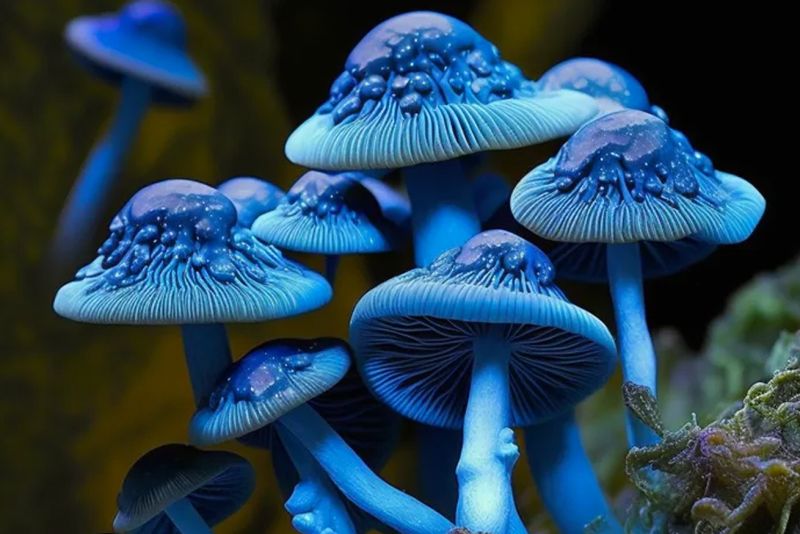In the vast kingdom of fungi, there exists a group of mushrooms that captivates both seasoned mycologists and curious enthusiasts alike—the Blue Meanie Mushroom (Panaeolus cyanescens). The Blue Meanie Mushroom (Panaeolus cyanescens) is a unique species of fungus known for its striking blue hue and potent psychoactive properties. It belongs to the Panaeolus genus and is native to tropical and subtropical regions, often growing on the manure of herbivorous animals. The mushrooms are known to thrive in warm, humid climates and their fruiting season coincides with the rainy season.
P. cyanescens contains hallucinogenic compounds, particularly psilocybin and psilocin, which can induce altered states of consciousness. Consuming these mushrooms can lead to vivid visual hallucinations, altered perception of time, enhanced creativity, and a deep sense of introspection. However, improper dosage or uncontrolled use can lead to adverse reactions and psychological distress.
Cultivation of Blue Meanie Mushrooms presents challenges compared to more commonly cultivated psilocybin-containing mushrooms like Psilocybe cubensis. The legal status of these mushrooms varies worldwide, with some jurisdictions decriminalizing or reducing penalties for personal use.
Psychedelic mushrooms, including the Blue Meanie, have potential therapeutic benefits, such as treating mental health conditions like depression, anxiety, and PTSD. The psychedelic experience induced by Blue Meanie Mushrooms promotes neuroplasticity, allowing individuals to break free from rigid thought patterns and explore new perspectives.
Taxonomy and Identification
The Blue Meanie Mushroom belongs to the Panaeolus genus, a group of small, brown-capped mushrooms commonly found in grassy areas. Panaeolus cyanescens, often referred to as Copelandia cyanescens, is renowned for its distinctive blue staining reaction. When bruised or injured, the mushroom undergoes a chemical reaction that results in a vivid blue or green coloration. This characteristic feature sets the Blue Meanie apart from other mushrooms, making it easily identifiable to those familiar with its traits.
Distribution and Habitat
Blue Meanie Mushrooms are native to tropical and subtropical regions, with a notable presence in parts of Southeast Asia, Central and South America, and even some southern regions of the United States. They typically thrive in dung-rich environments, often growing on the manure of herbivorous animals such as cows and water buffalo. The mushrooms are known to flourish in warm, humid climates, and their fruiting season tends to coincide with the rainy season in their respective habitats.
Psychoactive Compounds and Effects
One of the most intriguing aspects of the Blue Meanie Mushroom is its potent psychoactive properties. Like other mushrooms in the Panaeolus genus, P. cyanescens contains hallucinogenic compounds, particularly psilocybin and psilocin. These compounds belong to the tryptamine class and are renowned for their ability to induce altered states of consciousness.
Consuming Blue Meanie Mushrooms can lead to a range of psychoactive effects, including vivid visual hallucinations, altered perception of time, enhanced creativity, and a deep sense of introspection. Users often report a heightened connection to nature and an increased appreciation for the intricacies of the mind. It is essential to approach these mushrooms with caution, however, as improper dosage or uncontrolled use can lead to adverse reactions and psychological distress.
Cultivation
Given the allure of the Blue Meanie Mushroom, many enthusiasts are drawn to the idea of cultivating them for personal use. Cultivating P. cyanescens, however, poses some challenges compared to more commonly cultivated psilocybin-containing mushrooms like Psilocybe cubensis. Blue Meanies require specific conditions for successful cultivation, including a substrate rich in nutrients and a controlled environment with precise temperature and humidity levels.
One popular method for cultivating Blue Meanie Mushrooms involves using a substrate mixture of grains, such as rye or millet, combined with organic materials like vermiculite and gypsum. The mycelium, the vegetative part of the fungus, colonizes this substrate before initiating the fruiting stage, where the iconic blue-staining mushrooms emerge.
Legal Status
The legal status of Blue Meanie Mushrooms varies around the world. In many countries, the cultivation, possession, and consumption of psychedelic mushrooms, including those containing psilocybin, are illegal. However, some jurisdictions have decriminalized or reduced penalties for personal use, recognizing the potential therapeutic benefits of these substances.
It is crucial for individuals to be aware of and abide by the laws in their respective regions regarding the use of psychoactive mushrooms. The legal landscape is continually evolving, with ongoing discussions and research exploring the potential therapeutic applications of psilocybin-containing mushrooms.
Therapeutic Potential
Beyond their recreational use, psychedelic mushrooms, including the Blue Meanie, have garnered attention for their potential therapeutic benefits. Recent studies have explored the use of psilocybin in treating various mental health conditions, such as depression, anxiety, and post-traumatic stress disorder (PTSD).
The psychedelic experience induced by Blue Meanie Mushrooms is thought to promote neuroplasticity, allowing individuals to break free from rigid thought patterns and explore new perspectives. Some users report profound, positive changes in their mental health and overall well-being after carefully guided and supervised psychedelic experiences.
Conclusion
The Blue Meanie Mushroom, with its vibrant blue hues and potent psychoactive compounds, stands as a testament to the diverse and intriguing world of fungi. From its taxonomy and distribution to cultivation, legal status, and therapeutic potential, exploring the facets of this mushroom reveals a complex and multifaceted organism.
As research into the therapeutic applications of psychedelic mushrooms continues, the Blue Meanie Mushroom remains a subject of fascination for both scientific inquiry and personal exploration. As with any psychoactive substance, responsible use and an understanding of the legal landscape are essential. The journey into the world of Blue Meanie Mushrooms beckons those who are curious, daring, and respectful of the profound experiences that can unfold within the realms of this captivating fungus.







